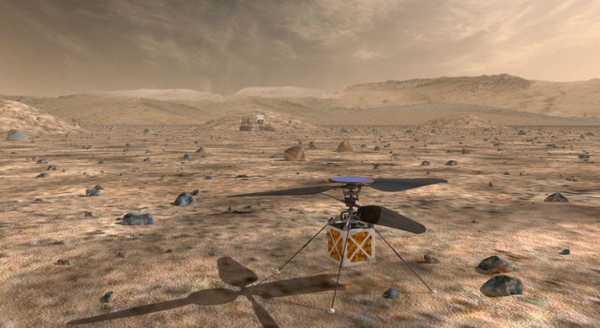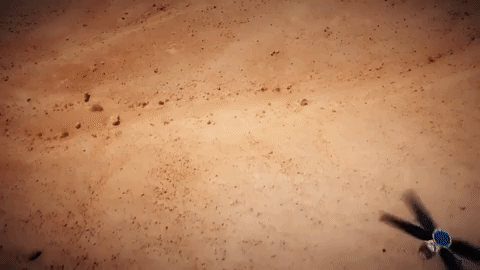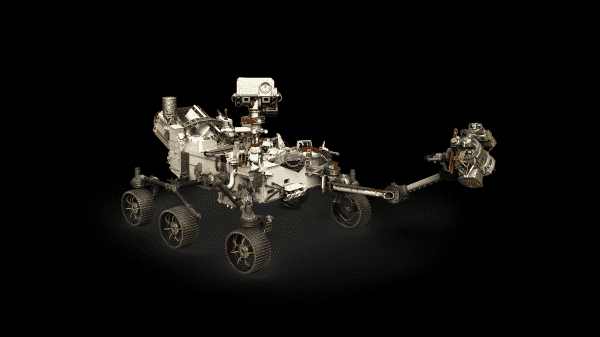
When the next Mars rover is lowered onto the red planet via rocket-powered crane for its mission in February 2021, it will be carrying some extremely high-tech tools. There will be a camera capable of detecting organic compounds in rocks, a machine that will test the conversion of C02 in the Martian atmosphere into oxygen, ground-penetrating radar for probing the Martian surface, and other instruments to study the geologic history of Mars.
And as NASA announced on Friday, the rover will be carrying something a bit more familiar that also happens to be a major feat of engineering: a helicopter.
The craft is called the Mars Helicopter, but it’s really more like a drone. Here’s an artist’s animation of what it could look like on Mars.

With the wings removed, it will be about the size of a softball. In all, it will weigh just about 4 pounds. It will be solar-powered, operate autonomously of human controls, and will be able to fly up to a few hundred yards at a time.
Why NASA wants to send a helicopter to Mars
It’s also not guaranteed to work. The goal is to test the viability of drone exploration of an alien world rather than conduct a scientific assessment of the planet.
At first, the helicopter will make very, very short flights, hovering just 10 feet in the air. But even one short flight will be an impressive engineering achievement, and the first time a helicopter has taken off on a world that is not our own. Already, prototypes of the Mars Helicopter have been tested in a facility that mimics the atmospheric conditions on Mars, the New York Times reports.
Mars’s atmosphere is less than 1 percent as dense as Earth’s. Flying on the surface of Mars is equivalent to flying 100,000 feet above sea level, NASA reported. To compensate for the thin air, the helicopter’s wings will spin at 10 times the rate of a typical earthbound copter to achieve lift.
In the future, NASA could deploy more drones to better assess the Martian surface or help guide the astronauts over obstacles during a human mission. Or, who knows, maybe they’ll help astronauts take selfies.
The mission, called Mars 2020 because it’s scheduled to leave Earth in July 2020, is the sequel to the Curiosity rover, which landed in Mars’s Gale Crater in 2012.
Mars 2020 will be exciting to watch
Like Curiosity, 2020’s design looks like a cross between Wall-E and a golf cart, and its purpose is similar: to search for clues that can teach us about the Martian past and whether life ever existed on the planet. It’s possible that Mars was once a living, water-filled world like Earth but died and dried out after losing its atmosphere to solar radiation.

NASA’s scientists are still deciding where, exactly, to land the rover. But once it’s roving, it will help in collecting data about the climate and geologic history of Mars and analyzing whether Martian natural resources could ever be used to benefit human explorers. (The Trump administration seems pretty gung-ho on the idea of sending humans to Mars one day. But there are no concrete missions set.)
Mars 2020 will be an exciting mission to watch. Currently, NASA is facing a bit of a lull in its planetary exploration missions. The Juno orbiter circling Jupiter may go offline this year. Cassini, the spacecraft that studied Saturn, ended its mission in 2017. The Europa Clipper, a mission to Jupiter’s icy, possibly life-harboring moon, won’t launch until well into the next decade. In 2019, we’ll have a New Horizons flyby of a mysterious Kuiper belt object to look forward to, but its uncertain if its mission will continue past 2021.
So we turn our eyes to Mars, and to the ever-fascinating question: Did anything ever live there?
Further reading: planets!
- The debate over Pluto will never die. Here’s the latest argument for why it’s a planet.
- Why the Cassini mission to Saturn was so damn cool
- Some photos of Jupiter to ogle
- Let’s leave planetary exploration to the robots. Here are the top seven ways a trip to Mars could kill you, illustrated.
Sourse: vox.com






